Moving SAP to AWS? Not cloudy, just clouding
Nowadays, less and less decision makers in IT raise the question whether it is worth moving IT systems to the cloud or setting them up on a cloud platform, more and more companies are opening to cloud solutions. But is this journey to the cloud so obvious also for the SAP systems?
The importance of this question became significantly relevant since SAP has announced that they are going to stop supporting the ECC platform from 2027. This decision forces SAP customers using older version of the software to start planning their migration to S/4 HANA as soon as possible. The transformation to S/4 HANA is a great occasion to modernize our system and raise the question, where we want to host our SAP system as well as where and how the migration should be managed.
This is where the public cloud really comes in as a potential platform solution for your SAP. However, at a first glance, it may seem strange that such a robust, monolithic system like SAP would “fit” in an environment that is more about microservice-based, automatically scalable, or even serverless solutions. Can SAP really be run efficiently and flexibly on a cloud platform, and is it really worth it?
Well, the short answer is yes, but we are planning to detail all the benefits and further possibilities of running SAP in the cloud (AWS to be precise), touching on all important areas, from flexibility and speed, availability, security, cost optimization to migration options, in this blogpost series.
We will even get to see how AWS serverless and event-driven solutions can be put at the service of SAP, for example to automate a system upgrade.
AWS as a leading provider
First of all, it is important to clarify why AWS is preferred over the other cloud platform services and when it is recommended to run your SAP in your own AWS environment instead of SAP’s managed cloud services.
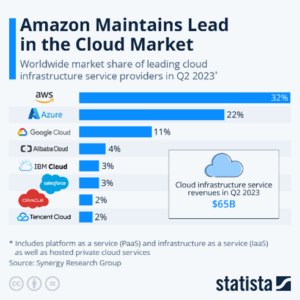
Amazon Web Services’ cloud service has been a market leader from the start, and it still holds a market share of around 32% even in Q2 2023. This is mainly due to the reliability of AWS, its innovative solutions and the continuous introduction and improvement of its services.
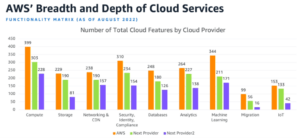

Forrás: AWS
With more than 200 services available and nearly 3,000 new features and capabilities released every year, AWS is the most innovative cloud provider.
In addition, AWS is recognized as a leader by several independent analyst companies. The most important ones are Gartner who has been naming AWS as a leader in Cloud Infrastructure and Platform Services (CIPS) for the 12th consecutive year, and ISG who has been recognized AWS as a leader in SAP HANA Infrastructure Services for the 5th consecutive year.
Based on the above, it is perhaps not an exaggeration to say that we are talking about the best IaaS, PaaS service in the world.
SAP on AWS
So, it’s cool that we can have the best possible provider for our systems and data, but is AWS just as good at supporting SAP?
Well, SAP’s partnership with AWS dates back to 2008, a time when other cloud providers either didn’t exist or were in the preview phase. In that year the two companies formed a Global Technology Partnership alliance, and the successful collaboration has continued unabated ever since. Thanks to the continuous co-development and reliability, more than 5,000 companies have chosen AWS to run their SAP systems and AWS has the largest SAP partner network.
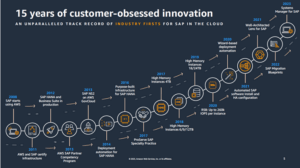
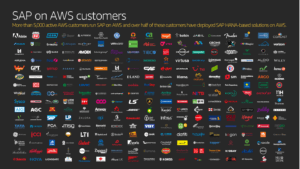
Forrás: AWS
What exactly does the SAP-AWS partnership mean?
SAP-validated AWS services: the two companies work closely together to test and analyze the AWS services and SAP finally validates those services and resource types that best fit to SAP system and can guarantee that our SAP landscape will work reliably. For example, you have a choice of more than 150 SAP-certified EC2 instance types (AWS virtual server services) for your NetWeaver applications, and for your HANA database you can use one of the 40 EC2 types, including one with up to 24 TB of memory. In addition, AWS releases a new generation of EC2s every year, making it extremely cost-effective to increase the performance of your resources year by year. But also there are well-defined set of supported operating systems and database engines that you can use in AWS to run your SAP systems.
SAP Reference Architecture: SAP and AWS jointly define a reference architecture and provide customers with recommendations on how to design our environment along the guidelines for running SAP in an optimal, cost-effective, and secure way. These recommendations incorporate the requirements of the relevant SAP Notes as well as best practices from the AWS Well-Architected Framework.
AWS services developed for SAP systems: as a result of common development, more and more services are being added to AWS specifically to support SAP systems. A few of these are mentioned here:
o Migration Hub Orchestrator‘s automated workflows make it easy to migrate the SAP NetWeaver-based applications to AWS.
o Using the Launch Wizard for SAP, you can drastically reduce the time required to deploy SAP systems, including setting up the network environment and EC2s, configuring operating systems, and even deploying SAP applications.
o You can back up your entire SAP environment in one step with AWS Backup thanks to its integration with Backint Agent.
o With Systems Manager for SAP, you can automate system startups as well as system upgrades.
o CloudWatch Insights for SAP can monitor the entire SAP environment from platform metrics to SAP application health.
o AWS SDK for SAP ABAP provides native access to AWS services from SAP application codes.
Self-operation or SAP RISE?
Once we have seen the benefits and possibly decided to choose AWS to run our SAP system in the future (we hope, most of our readers are already convinced of it by the time we get to this point 😊), the question arises who to entrust with the migration and operations. After all, both SAP migration (or greenfield design) and the use of AWS require new knowledge and experience that may not be readily available in your company.
Basically, you have two options: you can either use a specialized AWS partner or can choose SAP’s RISE (or some other cloud service).
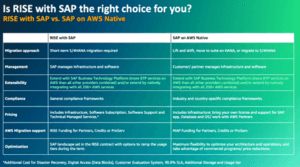
Forrás: AWS
The essence of the SAP RISE model is that SAP manages both the AWS platform (network, servers, OS, security, backup, monitoring, etc.) and the SAP landscape for you at the application level (base, deployment, upgrade, monitoring, etc.) within the framework of one single contract.
This is most worthwhile if you are running only your SAP environment in AWS, your other systems are running “on-premises” or on another cloud provider (and you don’t need integration between these systems), and if your primary concern is to have the entire SAP environment under one contract, in one hand, even if this implies some inflexibility and constraints.
However, if flexibility and speed are important to you, if you have other systems running in AWS and you want to integrate SAP with them, or if you have specific needs, then the so-called ’native’ direction is the right one, for which we recommend involving an AWS partner (for example TC2, as the first Hungarian Advanced Partner and Migration Competency Partner of AWS). Since SAP covers only 20-50-60% of a company’s business processes – depending on the industry, the other business applications are also definitely worth to be placed close to SAP (faster data connection, data gravity, no data transfer cost, etc.). You cannot do this with RISE, whereas an AWS partner can cover the whole AWS portfolio that are relevant for all of your business applications. In this case, for the migration and operation of SAP you can choose your well-established team of specialists (or TC2’s SAP partner network).
Additional benefits and opportunities
So far, we have learnt that AWS is a suitable, and perhaps the best, solution for running your SAP system. In the following blogposts we are going to look under the hood a bit and check the technological aspects of why it is worth moving to AWS.
We will show you in detail
- What automation options we have and what speed and flexibility you can achieve, whether it’s during the migration, deployment or operation;
- what HA and DR solutions exist to increase availability;
- how you can secure your data is and what tools are available to enhance security;
- how you can optimize costs;
- what methods you can use to migrate to AWS;
- when and how to make the HANA migration;
- what integration options you have in AWS, what services might be useful for you.
